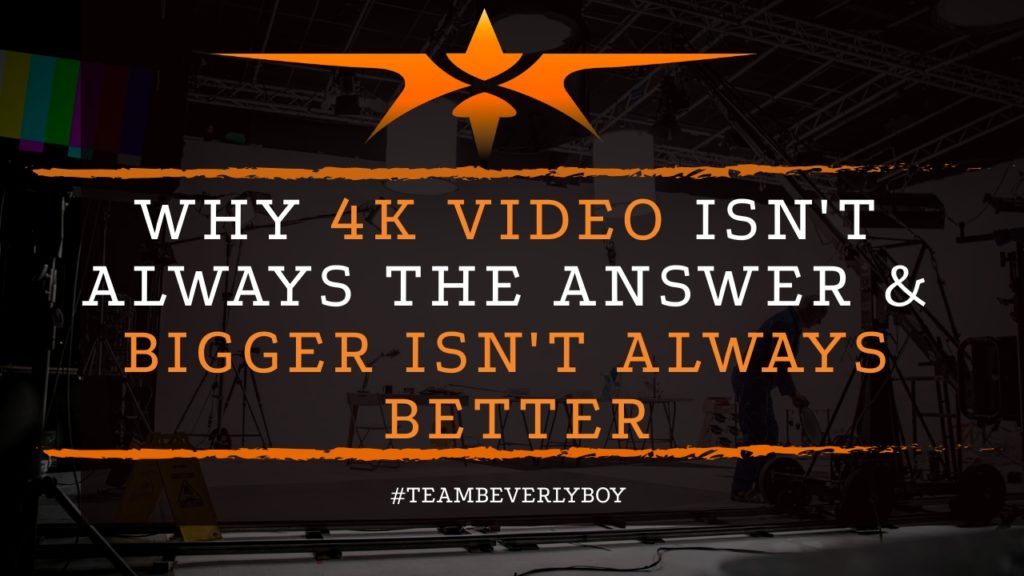
Why 4K Video Isn’t Always the Answer & Bigger Isn’t Always Better
Video footage is available in various “sizes” which represent the file size as well as the viewable size of the final rendered files that are delivered to you when your video project is done. And, while the initial reaction from you may be “choose 4K because that’s the best there is,” 4K video isn’t always the answer and bigger formats aren’t always better. In fact, although 4K video seems like the logical best option, and there are 4K benefits that you should be aware of, it’s not always the answer and there are alternate solutions that could provide an equally beneficial outcome for you.

Follow along as we explain.
What is 4K And What Does It Mean?
First, let’s get a solid understanding on exactly what “4K” even is! Essentially, 4K footage, or Ultra High Definition (UHD) footage references the resolution of the video image files that are used to produce your finished video project. The reference to 4K is because there are almost 4,000 pixels involved in the resolution which is actually 3840×2160 to be exact.
How does this 3840×2160 match up to other video formats that we are familiar with? To help you understand, and as a reference point, a 1080p (which is a 1080 pixel) represents 1920×1080. It is significantly smaller in finished file size design.
Can We Even Tell The Difference?
Our naked human eyes, although trained to see significant variances in the colors, shapes and visual elements that we view each day cannot see a HUGE difference in between 1080p and 4K in many cases. We do realize the resolution is better, and that images are more crisp and clear, but do we REALLY catch the very fine details of the 4K image over the other? Usually not!
However, if you’re thinking, “Why use 4K at all then?” stick with us, because there is great value and several 4K benefits that you’ll be happy to hear! First off, the most important reason to use 4K over other forms of video footage is the fact that 4K video offers the most pristine quality footage you can capture.
Starting out with top quality content allows for additional steps to take place as files are edited and reduced without losing any quality in the finished piece.
4K Benefits

So let’s take a look at the benefits of 4K films. As previously stated, one of the greatest benefits of 4K films is that 4K video renders top quality. It allows for maximum reframing of the shot in post-production.
Since there is more footage or viable material to work with for the editor, there is flexibility for the editor to scale up, zoom in, or otherwise adjust the shot in various ways without losing any quality. Such ability to reframe and alter in post-production is generally not as welcomed if the original footage is not captured with 4K precision.
Additional benefits that come during post-production when you have 4K footage include:
- The ability to create various post-production simulated camera moves.
- The ability to use post-production image stabilization software to stabilize the image.
- The ability for post-production graphic editors to position special graphics with precision.
So, since 4K benefits seem to be plentiful enough, and this is the “best quality” file size to begin with, what is it that leads to the title here “Bigger isn’t always better?” Let’s take a look!
Why Bigger Isn’t Always Better
Bigger isn’t always better and that certainly goes for 4K footage versus smaller, easier to condense, easier to store forms of video media. Post-production processes that involve the use of 4K video footage can be a time consumption nightmare.
In fact, storage challenges are at the top of the list when it comes to disadvantages associated with the use of 4K footage versus other forms of video footage and file sizes.
In fact, most of the consequences or potential drawbacks of 4K video revolve around the fact that 4K footage is more expensive and time-consuming to properly produce.
Additional drawbacks to 4K footage include:
- Longer time spent transcoding footage into editing programs, which equals longer waiting time in editing.
- Inability for certain hardware systems (computers) to handle 4K footage which leads to clients that cannot access their files or clients that suffer from poor playback or loss of image quality when attempting to view files.
- Added storage space required during production when shooting the footage as well as additional storage space and hard drives when editing in post-production. The same storage space issues trickle down to the end client as well when finished 4K files are delivered in mass sizes.
To 4K or Not to 4K, That is the Question
So which should you choose? Which is best for your particular video project? Deciding whether to go with 4K or to skip the hassle and just opt for something a little smaller, less labor intense and easier to move forward with really depends largely on the project itself.
If you’re creating video content for social media, you’re probably fine without opting for 4K. In fact, for most cases, good, old fashioned 1080 is sufficient and ideal for projects.
Turn to Team Beverly Boy
The best way to know whether your project should be shot in 4K or not is to discuss the project with your video production company.
Still have questions? Give Beverly Boy Productions a call! We can’t wait to assist you!


